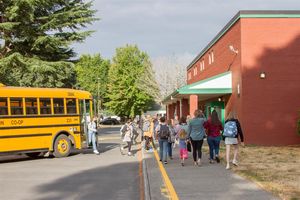Monday, January 9, 2023
VOTERS TAKE NOTE: EP&O Replacement Levy ballot will list higher tax rate than the actual lower rate
Woodland Public Schools wants to inform voters that the estimated tax rate for the replacement Educational Programs and Operations Levy on February 14th’s election ballot will contain an error, showing the replacement levy as collecting an estimated tax rate of $2.05 per thousand of assessed property value, when the actual estimated rate is much lower at $1.91.
Woodland Public Schools Director of Business recently recalculated the tax rate estimates using recently updated property values and found the estimated tax rate for the replacement levy will be lower than originally calculated, now $1.91 per thousand of assessed property value per year versus $2.05, the figure that was initially released.
Since ballots have already been finalized, the district wants to inform all voters that the figures listed on the ballot will be incorrect, listing the existing levy rate at $2.25 per $1,000 of assessed property value in 2023 versus the actual amount of $2.10 and the renewal levy will be listed as collecting $2.05 each year (2024, 2025, and 2026) instead of the actual estimated rate of $1.91 per year.
“We want to assure voters that the actual estimated tax rate of the replacement levy, if renewed, will be $1.91 per thousand of assessed property value, not $2.05,” explained Michael Green, Superintendent of Woodland Public Schools. “Our Board of Directors voted to reduce our levy collection in an effort to provide some tax relief to the community, and the error on the ballots might confuse some.”
Learn more about the Replacement Educational Programs and Operations (EP&O) Levy
On Thursday, October 20, 2022, the School Board approved a resolution to run a three-year Replacement Educational Programs and Operations (EP&O) Levy to replace the district's current levy which expires at the end of 2023 in a special election on Tuesday, February 14, 2023.
 The School Board worked diligently to consider economic hardships that may be facing Woodland's families and chose to decrease the amount of funds collected in 2024 to provide some tax relief to the community. As a result, the replacement levy is anticipated to carry a lower estimated tax rate than what voters are currently paying:
The School Board worked diligently to consider economic hardships that may be facing Woodland's families and chose to decrease the amount of funds collected in 2024 to provide some tax relief to the community. As a result, the replacement levy is anticipated to carry a lower estimated tax rate than what voters are currently paying:
- 2023: $2.10 per $1,000 of assessed property value.
- 2024: $1.91 per $1,000 of assessed property value.
- 2025: $1.91 per $1,000 of assessed property value.
- 2026: $1.91 per $1,000 of assessed property value.
(These are estimated rates based on typical assessed valuation growth)
 Click here to download the Replacement Levy Informational Flier
Click here to download the Replacement Levy Informational Flier
Why is the replacement levy important?
 Without a replacement levy, millions of dollars will be cut from educational programs and services beginning with the 2023-24 school year. The following educational programs are funded by local levy dollars and may be reduced in size or eliminated entirely:
Without a replacement levy, millions of dollars will be cut from educational programs and services beginning with the 2023-24 school year. The following educational programs are funded by local levy dollars and may be reduced in size or eliminated entirely:
- Arts, Music, Athletics & Extracurricular Clubs
- Career Center at Woodland High School
- Class Size Reduction, mostly at WMS & WHS
- Current Technology, Textbooks and Curriculum
- Custodians, Maintenance and Grounds Staff
- Elementary Counselors / Social Workers
- Family Community Resource Center
- Paraprofessionals / Teaching Assistants
- PASS - WHS Program to Reduce Dropout Rate
- School Bus Transportation
- School Secretaries
- Special Education Programs
- Specialized & Advanced Placement Courses
- Student Behavior & Discipline Support Staff
- Student Supports to come ready to learn
- Summer School and Credit Recovery Programs
- Teacher and Staff Training
- Teaching Improvement Specialists
Frequently Asked Questions
If you have a question that isn't answered below, please send it to Eric Jacobson, our Communications Manager at jacobsoe@woodlandschools.org and we will be sure to answer any question you have.
The estimated levy tax rate for the three years is $1.91, yet the total amount collected increases in 2025 and 2026. How does that math work?
When preparing a levy, school districts must estimate the growth expected to see over the course of the levy. With a three-year levy, the district’s business manager and team review growth forecasts and use a conservative estimate to prepare the levy rates and amounts.
The amount collected by the levy each year if approved is as followed:
- Current Year (2023): $6,100,000
- 2024: $5,900,000
- 2025: $6,250,000
- 2026: $6,625,000
You may notice that the levy amount decreases from 2023 to 2024 (from $6,100,000 down to $5,900,000). The Board of Directors wanted to address inflationary burdens on families by reducing the levy amount. While reducing the amount does mean the District will have to reduce spending in certain areas and develop creative approaches in others, the Board of Directors felt it was wise for the District to tighten its belt just as Woodland families have had to during these inflationary times.
 Woodland is a growing city. School enrollment is increasing as well. The Washington State Superintendent of Public Instruction projects year-over-year growth of about 100 students in each of the three years of the proposed levy. The annual increases in the total levy are a historical practice that helps our schools keep up with increased enrollment and costs. With the growth in housing, business, and industry the total value of property in the school district increases, spreading the tax burden.
Woodland is a growing city. School enrollment is increasing as well. The Washington State Superintendent of Public Instruction projects year-over-year growth of about 100 students in each of the three years of the proposed levy. The annual increases in the total levy are a historical practice that helps our schools keep up with increased enrollment and costs. With the growth in housing, business, and industry the total value of property in the school district increases, spreading the tax burden.
Historically, Woodland Public Schools is very conservative with its tax rate estimates and the actual tax rates tend to actually be lower than estimated. For example: 2023's tax rate is estimated at $2.25. When the community passed the existing levy in 2020, the tax rate for 2023 was estimated at $2.36. The actual levy rate represents a decrease of $0.11 per $1,000 of assessed value.
Will my total EP&O tax bill remain the same throughout the three-year term of the levy?
The answer depends on the assessed value of your property and the total value of all property in the school district.
If the total value of your property goes up faster than the average of all of the properties in the school district, you may see modest increases in your EP&O tax bill. However, if the total value of the rest of the properties in the school district increases at a faster rate than your property, you may see a decrease in your EP&O taxes.
Didn’t the legislature fully fund schools a few years back?
No. The state fully funded their "prototypical model," which is well below what is actually required to meet the needs of students and our community. For years, the state has failed to fully fund public schools, requiring the local taxpayers to pick up the gap in funding through the local levy. There continues to be a significant gap in what the state funds and what it takes to operate the schools in our community.
Local EP&O funding supports:
- 76% of our staff who keep our technology infrastructure and tools working
- 38% of our staff who keep floors vacuumed, windows washed, and lunchrooms clean
- 43% of our staff who keep the lawns mowed, buildings painted, Heating Systems running, and facilities repaired.
- 19% of all costs associated with keeping students nourished
- 35% of district-level administrative and support staff
- 72% of our Basic Ed Paraprofessional, health room, and Program Specialist Staff
- 100% of extracurricular, arts, music and athletic programs
- 61% of our school nurse
- 78% of our substitute costs
- 23% of our Yale School Staff
- 11% of our Woodland Middle School Staff
- 21% of our Woodland High School Staff
- 100% of Programs like PASS at WHS, and the Family Community Resources Center.
- 12% of our total Special Education expenditures (about $600,000)
Is there a connection between the value of my home and school taxes?
 Yes. Homeowners typically see the equity and the value of their home significantly increase in relationship to how local schools perform. The National Bureau of Economic Research found that “A $1.00 increase in per-pupil state aid increases aggregate per pupil housing values by about $20.00, indicating that potential residents value education expenditure” The entire report is available HERE
Yes. Homeowners typically see the equity and the value of their home significantly increase in relationship to how local schools perform. The National Bureau of Economic Research found that “A $1.00 increase in per-pupil state aid increases aggregate per pupil housing values by about $20.00, indicating that potential residents value education expenditure” The entire report is available HERE
Why does the school district need to increase the amount of levy funds it collects each year?
As the number of students who attend Woodland Schools continues to grow combined with inflation throughout the economy, so do the costs associated with operating schools and paying its employees. If the levy did not increase, we would, over the course of time, lose our ability to keep up with the community’s expectations for a quality school program for its children.
My tax bill lists “School Tax 1” and “School Tax 2.” Don’t these two taxes fully support local schools?
A few years back, the state legislature performed a “levy swap.” They increased the portion of property taxes that go to the State to pay for schools and labeled this “State School Tax 2,” while, at the same time, decreased the amount that school districts can collect. (State School Tax 1 is the pre-McCleary tax)
Simultaneously, the state mandated school districts increase the salaries of teachers and other staff. The levels of state funding continue to underfund required programs like special education and do not match the expectations of the local community for a quality educational program.
In other words, the state legally requires school districts to provide many services that districts receive little or sometimes no funding at all to provide. These services are called “unfunded mandates.” Without funding, school districts must either make cuts to other programs or request funding from their communities in the form of local levies.
Nearly every school district in Washington State needs a locally-funded levy in order to provide the programs and services communities expect in their schools.
How are Woodland Schools doing? Am I getting a return on investment?
Woodland Public School students have shown academic growth in recent years well above the state average. Performance on state tests is strong and growing. Our graduation rate trends continue to be strong. The most recent performance target report to the board details the progress of our schools and students in preparing students for their future.
What will be cut if the levy is not approved?
If the levy is not approved, the school board must reduce spending by more than $3,000,000 in school year 2023-24. The cuts will be deep and difficult.  Some programs that are significantly funded by the local levy but still underfunded (such as special education, which is underfunded by about $600,000) must be maintained because they are mandated by state and federal law, even though the state does not fully fund them.
Some programs that are significantly funded by the local levy but still underfunded (such as special education, which is underfunded by about $600,000) must be maintained because they are mandated by state and federal law, even though the state does not fully fund them.
- Class sizes, particularly in grades 4-12, will increase significantly. Many classes that typically have lower enrollment (Advanced Placement, arts, music, etc.), particularly at the Middle School and High School level, may have to be eliminated entirely.
- Extracurricular programs such as drama, clubs, athletics, pep-band, etc. will likely be reduced or eliminated.
- Textbooks, library books, and other curriculum materials will not be updated.
- Staffing that supports teaching, school cleaning and maintenance, and school/district administration and operations will likely be significantly reduced. Technology and technology supports will likely be deeply impacted.
How does funding in Woodland Public Schools compare with other school districts in the area?
Woodland receives substantially less money from the state to hire staff and operate its schools than all of the school districts to the south of us.
Every district in Clark County (with the exception of Green Mountain Schools District) receives an additional 6-12% in “regionalization” enhancement funding, yet we hire our staff from the same available pool of employees.
The vast majority of our teaching staff drives to work through school districts with enhanced funding, districts where they could easily find employment should Woodland not remain competitive.
In order to retract and retain high-quality teaching and support staff, we must offer competitive wages and benefits. The district depends on the levy to make up for this funding inequality from the state.
My local school tax rate for schools seems to fluctuate year-to-year over the past several years. In 2021 it was $2.36, in 2022 it was $2.32, and in 2023 it's estimated to be $2.10. Why is this?
In 2020, voters approved a three-year levy for the tax years 2021-2023. The district conservatively estimated that the tax rates would be $2.37 in 2021 and $2.36 in 2022 and 2023. Thanks to conservative estimates and the ongoing growth in Woodland's population and property values, the tax rate needed to collect the levy amount lowered over the subsequent years following the replacement levy's passage.
If you have a question that isn't answered below, please send it to Eric Jacobson, our Communications Manager at jacobsoe@woodlandschools.org and we will be sure to answer any question you have.